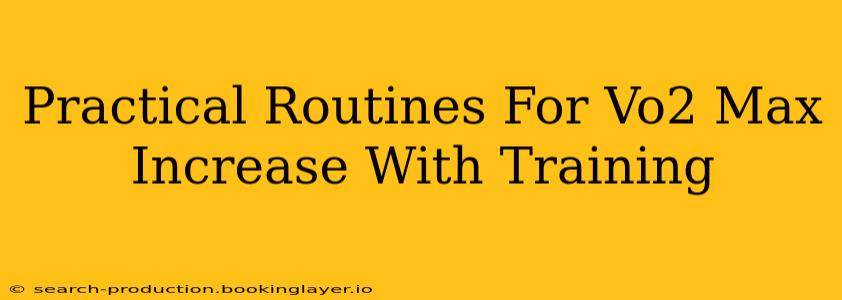Improving your VO2 max – the maximum amount of oxygen your body can utilize during intense exercise – is a significant goal for many athletes and fitness enthusiasts. A higher VO2 max translates to better endurance, faster recovery, and improved overall performance. But achieving this requires a structured and consistent training approach. This post outlines practical routines you can incorporate into your fitness regimen to boost your VO2 max.
Understanding VO2 Max and its Importance
Before diving into training routines, it's crucial to understand what VO2 max represents. It's a measure of your cardiorespiratory fitness, reflecting your body's efficiency in delivering and utilizing oxygen. A higher VO2 max indicates a more efficient cardiovascular system and stronger aerobic capacity. This is beneficial for:
- Improved endurance: Sustaining intense exercise for longer periods.
- Faster recovery: Returning to your pre-exercise state quicker.
- Enhanced performance: Achieving better results in endurance-based activities.
- Better overall health: Reducing the risk of cardiovascular disease and other health problems.
Key Training Principles for VO2 Max Improvement
Several training principles are fundamental to maximizing your VO2 max gains:
- Consistency: Regular training is paramount. Aim for at least 3-5 sessions per week.
- Progressive Overload: Gradually increase the intensity, duration, or frequency of your workouts to continuously challenge your body.
- Specificity: Tailor your training to your specific sport or activity.
- Recovery: Allow for adequate rest and recovery between training sessions to prevent overtraining.
- Variety: Incorporate different types of training to prevent plateaus and avoid boredom.
Practical Training Routines to Boost Your VO2 Max
Here are some practical training routines you can implement:
1. Interval Training: The High-Intensity Approach
Interval training involves alternating between high-intensity bursts and periods of rest or low-intensity activity. This is highly effective for improving VO2 max. Examples include:
- High-Intensity Interval Training (HIIT): Short bursts (e.g., 30 seconds) of intense exercise followed by brief recovery periods (e.g., 60 seconds). Repeat 8-12 times.
- Tempo Runs: Sustained effort at a comfortably hard pace for a set duration (e.g., 20-40 minutes).
- Fartlek Training: Swedish for "speed play," this involves varying your pace throughout your run, spontaneously increasing intensity for short bursts.
2. Long, Slow Distance (LSD) Training: The Endurance Builder
LSD training focuses on endurance and building your aerobic base. This involves sustained effort at a low to moderate intensity for an extended period (e.g., 60-90 minutes). LSD training improves your body's ability to utilize oxygen efficiently over time.
3. Strength Training: The Often Overlooked Component
While primarily focused on building muscle strength, strength training can indirectly improve VO2 max by improving your body's overall efficiency and reducing the energy cost of movement. Incorporate exercises that target major muscle groups, focusing on compound movements like squats, deadlifts, and bench presses.
4. Cross-Training: The Variety Factor
Cross-training involves incorporating various activities to build overall fitness and avoid plateaus. This could include swimming, cycling, or even hiking. The variety keeps your training engaging and challenges your body in different ways.
Monitoring Progress and Adjusting Your Training
To effectively track your progress and make necessary adjustments, consider:
- Regularly monitoring your heart rate: Pay attention to your heart rate zones during training.
- Using a fitness tracker or smartwatch: Many devices can provide detailed data on your workouts.
- Periodically assessing your VO2 max: Consider professional VO2 max testing for a precise measurement of your progress.
- Listening to your body: Pay attention to signs of overtraining, such as fatigue, muscle soreness, or decreased performance.
Conclusion: Consistency is Key
Improving your VO2 max is a journey that requires dedication and consistency. By incorporating these practical routines and paying attention to your body's signals, you can significantly improve your cardiorespiratory fitness and achieve your fitness goals. Remember to consult with a healthcare professional or certified trainer before starting any new workout program. The key is to find a training plan you enjoy and can stick with long-term. Your improved VO2 max will be the reward for your consistent effort.

